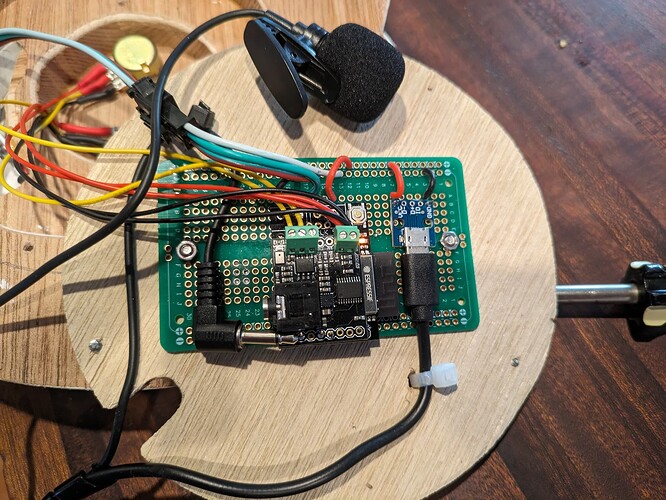Hi Team - I think i might have acquired the wrong mic for use with the external sensor board since when i plug it into the jack, i don’t see any meaningful input coming from the analogInputs[] collection. as soon as i unplug it, i see that the on board mic appears to pick up the inputs as expected. The reason why the on-board mic is not going to work well for my application is because it’s gonna be enclosed into the work piece, shown here with the electronics exposed. they are attached to the inside of a cover that is screwed and enclosed in the system.
The sensor board needs line level audio. You’d need a powered microphone that amplifies the signal up to line level, like what headphones would use.
The analog inputs aren’t intended for audio, but can be used for sensors etc.
Mic or aux jack sound can be read from the other variables like frequencyData, energyAverage, etc.
thanks for the help!
ah, i have potentiometers connected to analog inputs for different effects (dimmer + program selection). they’re working as expected.
i was thinking the mic would affect frequencyData[] but it sounds like the mic needs its own power source to accomplish this, which is not what i presumed. the onboard mic works pretty well, but i had concerns that if it were enclosed in the wooden body of my project, it might not be responsive enough.
i’m very inexperienced with programming using frequencyData[] so i might be a bit out of my league here. i’ll see if i can make-do with the on board mic since a powered mic might be too unwieldy for the application.
I was just clarifying that the mic won’t impact analogInputs[] because your original post mentioned them:
But sounds like that’s working fine for the potentiometers.
Yes, the audio from the built in mic or the aux jack will change the values in the frequencyData[] array, but only if its loud enough for the sensor board to hear it. An non-amplified mic is a lot weaker than line level and needs to be preamplified up to line level with an preamplifier. The “preamplifer” and “line level” are terms in the audio world.
Something like this could work, though I haven’t tried it, and it would be relatively large and need it’s own power:
https://www.amazon.com/ATNEDCVH-preamplifier-Headphone-amplifier-phonograph/dp/B0945RFJ6Z/
As an alternative, you could use a mic that has a built in amplifier. These will require a power source.
There are inexpensive boards that have that built in like this (again, not something I’ve tried):
https://www.amazon.com/Electret-Microphone-Amplifier-Adjustable-Breakout/dp/B08N4FNFTR/
For something like that, you’d want to power it from the 3.3v and GND on the sensor board analog input side, which has some noise filtering. That board looks similar to the circuit for the built in mic. You’d need to wire the GND and OUT signals to a cable to plug in to the jack. Or if you are feeling more adventurous, hack the sensor board to remove the jack and feed the signals directly.
This topic was automatically closed 120 days after the last reply. New replies are no longer allowed.
